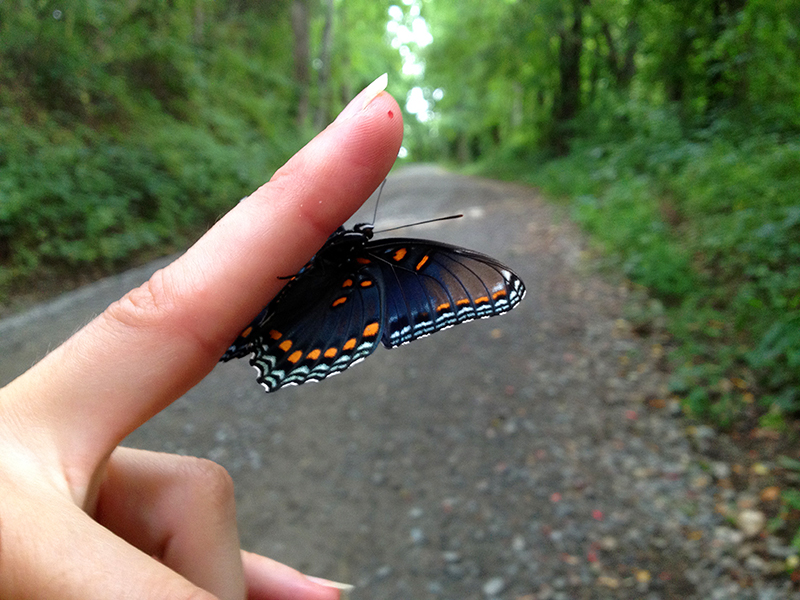I was walking with Tuck near here the other night and came across the most beautiful butterfly in the middle of a gravel road. It was one I didn’t recognize, which is always exciting.
It was dark in the woods so this butterfly’s colors are hard to see, but it was the most amazing shade of navy blue fading into bright, iridescent turquoise. I’d never seen a live butterfly in this particular color. True blue (not purple-blue) is such a rare color in the natural world that it doesn’t seem real when one sees it.
I very gently coaxed it on my hand so I could move it off the road, and saw its underside was equally beautiful. Sorry for the unintentional flip off—that was the finger it chose!
After taking these shots so I could ID the butterfly later, I put it on the bank and went on my way, very, very happy to have seen for just a few minutes something of such incredible beauty on my evening walk.
The trip was made even more joyful when I flushed a few quail out of a hedgerow beside the road. This was wonderful to see as quail are really in trouble in Virginia. The Department of Inland Game and Fisheries reports, in their Northern Bobwhite Quail Action Plan for Virginia:
Populations of northern bobwhite quail and other bird species with related habitat requirements have experienced severe long-term declines in Virginia over the past 50 years. In colonial times, farming created habitats that began to favor quail. As land was cleared and farmed, quail populations flourished. For perhaps 200 years or more, quail were one of the most common birds of the rural Virginia landscape. During the first half of the 20th century, as a shift from a rural-farm to urban-industrial economy began, idled and abandoned farms continued to support quail populations. However, since then major land use changes have taken place. Virginia’s agricultural landscape became dominated by large, intensively managed crop fields, fescue pastures, and hayfields.
Total farmland acres declined. In 1900, approximately 80% of Virginia’s landscape was in open agricultural land. Today agricultural lands make up only 34% of our landscape. Many of the formerly open farm fields are now dominated by intensively managed pine forests. While cut-over timber lands still provide some early-succession cover, plant diversity is low and productivity for quail is poor. The loss of early succession habitat, particularly nesting cover and brood range, has been identified as the most significant factor limiting quail populations. The bobwhite is a legacy species in Virginia and their decline has led to concerns about ecological, economic, and recreational impacts throughout rural Virginia.
Anytime you can spot a threatened species in the wild is encouraging. It makes me glad to live in an area that’s still suitable to sustaining important wildlife biodiversity.
But back to butterflies…at home I got out my field guide and opened right to the page with this butterfly on it. Weird. Anyway, it is a red-spotted purple, which is supposedly common in this area though I have never come across one until now. Strange name, too, for a blue butterfly with orange spots!
And then yesterday I was walking in the house and saw a red-spotted purple flying in my flower garden. Now that I know what it is, it’s easy to identify by its more rounded lower wings that lack the extended hind wings that identify swallowtails, below:
(Image source: http://www.edupic.net/lifecycle.htm)
And that’s your daily lepidoptery lesson, with a little quail digression!



